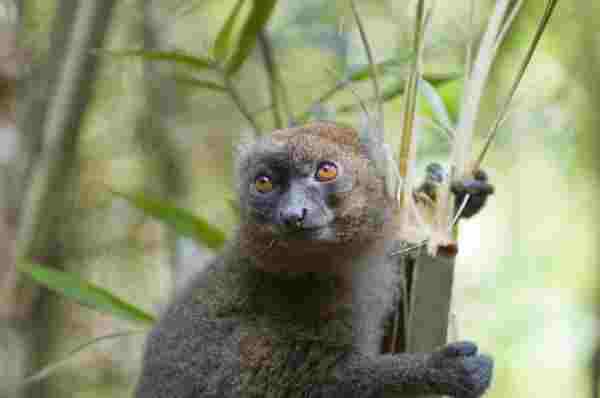While giant pandas are undoubtedly the most popular animals among those that eat bamboo, there is an array of other species with a distinctive diet. Animals that enjoy bamboo range from lemurs to elephants and gorillas in between, with each species having its own variations regarding the specific types of bamboo they consume given its availability.
Table of Contents
This proves that the intricate ancient plant can provide sustenance for animals across multiple ecosystems, making it one of the most versatile sources of nutrition for many creatures worldwide.
Find out what animals eat bamboo from the list below:
1. Elephants
Scientific name (Family): Elephantidae

Although the Asian elephant is most famous for its love and consumption of bamboo, any species would enjoy it if given a chance. In the Asian continent, bamboo is extremely plentiful and makes up a huge portion of an elephant’s diet. They require vast amounts of food to sustain themselves and can consume up to 330 pounds daily; a consequence of this large appetite is that a single herd can devour an entire forest in as little time as several days.
This could seem alarming, except for the fact that bamboo grows so quickly that it rarely reaches a point of scarcity. All this makes it easy for these hardworking elephants to keep their bellies full.
2. Giant Pandas
Scientific name: Ailuropoda melanoleuca

The giant panda is an iconic animal known around the world for its remarkable diet of exclusively bamboo. The impressive consumption levels of this plant are astounding as it provides them with essential nutrients as well as sustenance. In particular, wild pandas’ preference for living in bamboo forests helps keep their diet balanced and filled with fresh food sources.
Interestingly, if it ever becomes scarce or unavailable, these animals resort to other plants and grasses, however, nothing can quite replace the allure of an endless supply of bamboo shoots.
3. Red Pandas
Scientific name: Ailurus fulgens

Red pandas are the dainty cousins of giant pandas, and although much smaller, they have just as hearty an appetite. While their love of bamboo is well-known, these animals will eat up to 9 pounds per day–an impressive amount for creatures that don’t tip the scales at more than 10 pounds.
But if they find access to other small animals and birds, then they’ll munch on those too. They live mostly in the same parts of Eastern Asia as their larger relation and prefer living near bamboo forests where their preferred food is in abundance.
4. Chimpanzees
Scientific name: Pan troglodytes

When it comes to mealtime, chimpanzees usually have their eye on the fruit. But if bamboo is available during its brief season in Africa, chimps will not pass up the opportunity to indulge. Found mainly in tropical forests, chimpanzees value this resource for both the leaves and shoots that it provides.
If a chimpanzee finds themselves fortunate enough to encounter other food sources such as plants, seeds or even a deceased animal carcass – they will happily chow down.
5. Golden Monkey
Scientific name: Cercopithecus kandti

The species of monkey known to typically reside in central African bamboo forests is quite fond of its food source, which makes sense since it’s available to them throughout the year.
Despite this relentless consumption of bamboo shoots and branches, these monkeys are also adaptable, recognizing that even as key nutrient sources may become scarce at certain points across their range or seasonally, they can switch their diets to incorporate fruit for supplementary sustenance.
6. Mountain Gorillas
Scientific name: Gorilla beringei beringei

Gorillas are undoubtedly impressive animals due to their massive size and strength, but their diet may come as a surprise. Living mostly off of plants, gorillas will make meals of over 142 different plant species in the wild. Bamboo is one such species, with males consuming around 40 pounds of leaves and shoots per day.
Females aren’t far behind, need about 33 pounds each day to sustain themselves. Not being able to rely on bamboo year-round, however, gorillas have adapted throughout time to get the nutrition that they need from other sources when bamboo isn’t available.
7. Bamboo Rat
Scientific name (subfamily): Rhizomyinae

Bamboo rats may not seem intimidating, given their small size and slow movements, but they can be troublesome to farmers and agricultural workers. These four species of rodents are native to Asia, where they feast primarily on bamboo before turning to other sources of food as a last resort. While usually weighing no more than a few ounces at most, some of these creatures can hit the scales at 9 pounds!
This makes them particularly immobile, yet capable of causing great damage to crop fields or gardens. Despite their sluggish nature and timid behaviour, these unusual rats remain an important pest that must be monitored in agricultural regions all over their native habitats.
8. Bamboo Lemurs
cientific name (genus): Hapalemur

Bamboo lemurs are an unusual species, not only due to their curious diet of bamboo but also their limited habitat. Found only on the island of Madagascar, they inhabit dense bamboo forests where a steady supply of edible bamboo can be found high up in the trees.
Despite their specialization in consuming something that is lethal to many other animals, researchers are still puzzled as to how these primates process the large amounts of cyanide found within the bamboo they consume.
9. Termite

The tiny bug with a huge appetite, the termite, loves to feast on bamboo. This arduous bug spends its time boring through the tough stalks of bamboo like a bee eats through nectar-filled flowers.
Measuring in at a mere few millimetres, these little buggers can cause immense damage to the widely used building material, costing victims thousands of dollars in damages.
Bamboo is just not their only delicacy: they will also eat wood, gypsum board, paper products and even insulation material.
10. Bamboo borer

The bamboo borer is an insect native to Southeast Asia and India, known for its ravenous appetite for bamboo shoots. It starts by boring a small hole into the bamboo stem and eventually hollowing it out, resulting in a hollow pipe-like structure.
Infestations can spread quickly through an area as they can even evade termite chemical barriers easily, creating devastation among forests of bamboo as they consume all the shoots.
Final Words
While the giant panda is without a doubt the most famous animal associated with eating bamboo, it is its smaller cousin the red panda that might take second place.
Other animals who enjoy eating this plant include chimpanzees and mountain gorillas, but they only feast occasionally as opposed to all the time like bamboo lemurs and rats.
Out of all these animals, the bamboo lemur might be considered the biggest fan – being so committed to its favourite food that it consumes nothing else!
Reference:

Rahul M Suresh
Visiting the Zoo can be an exciting and educational experience for all involved. As a guide, I have the privilege of helping students and visitors alike to appreciate these animals in their natural habitat as well as introducing them to the various aspects of zoo life. I provide detailed information about the individual animals and their habitats, giving visitors an opportunity to understand each one more fully and appreciate them in a more intimate way.









